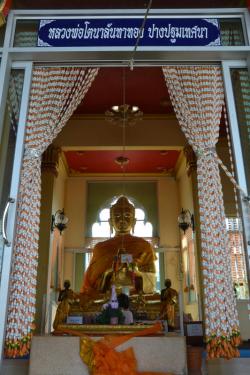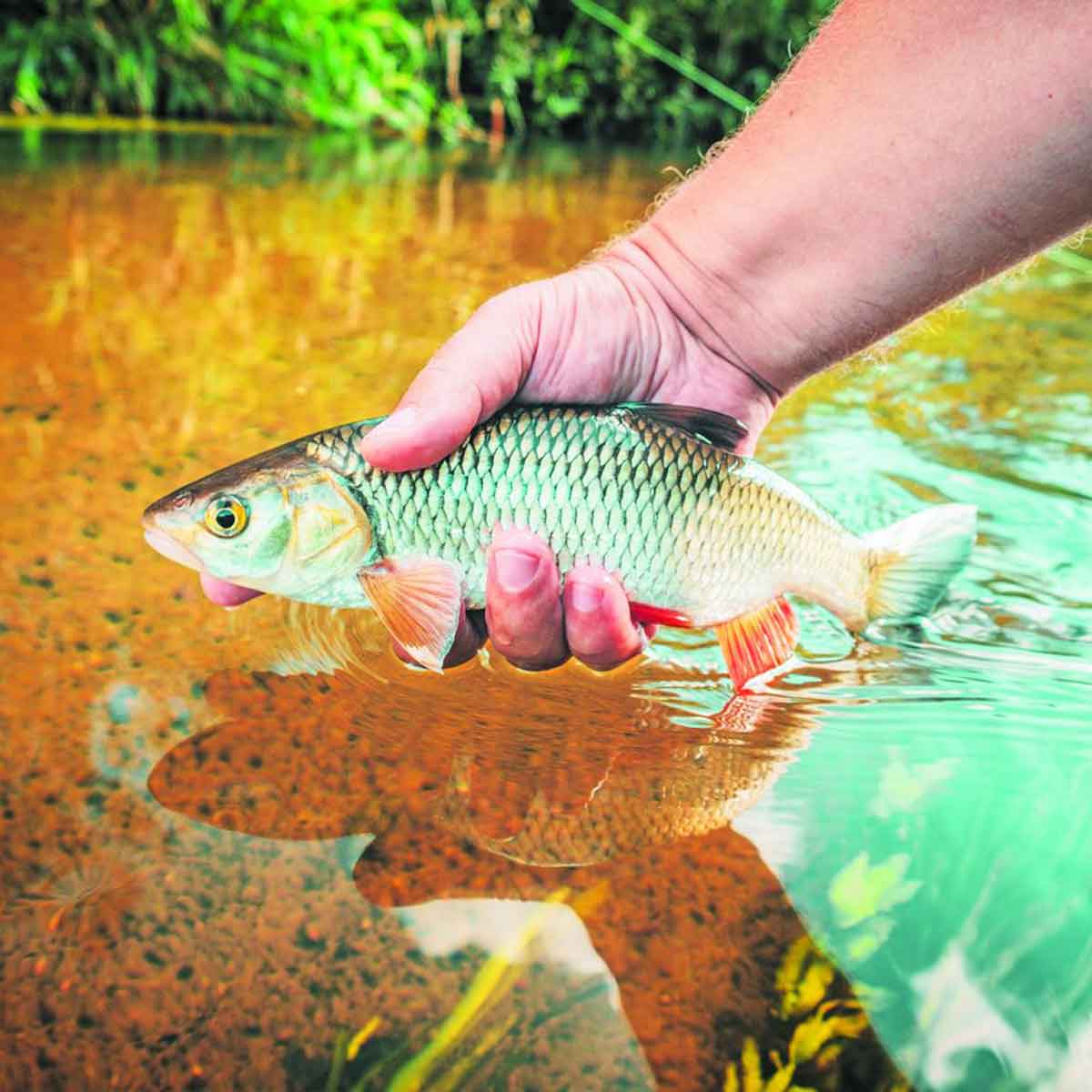It was both a sunny and rainy day in Nonthaburi province. Sprays of water were sprinkling our skin as a chartered boat whisked us down the Chao Phraya River around Koh Kret, an island where the descendants of Mon immigrants during the Thonburi period live and still maintain their Mon culture. Throughout this five-hour trip, we hopped on and off the boat to visit 10 temples on and around Koh Kret during the Nonthaburi Provincial Administration Organisation's annual boat excursion project. The PAO provides two free five-hour boat trips per day on Saturdays, Sundays and public holidays until the end of September. Temples on the list feature good examples of the Ayutthaya and Rattanakosin periods' architecture, art and murals.
Koh Kret is an island in the middle of the Chao Phraya River in Pak Kret district. It is widely known for premium-quality pottery and delicious food. Tourists mostly like to stroll, buy pottery, food and vegetables and take a boat ride around the island. Famous delicacies include thodmun nor kala (a fish cake added with a local plant from the same family as ginger), khao chae (Mon-style iced scented rice soup with assorted side dishes), crispy fried flowers and Thai desserts.
According to the Nonthaburi Provincial Office of Tourism and Sports, Koh Kret, or formerly known as Koh Sala Kun, came into existence due to the digging of a canal as a shortcut from the Chao Phraya River in 1722 in the reign of King Thai Sa (1709-1732) during the Ayutthaya period. This canal was named Khlong Lat Kret Noi. Later, when the waterway changed its course, the tide became stronger and caused soil erosion, making the canal larger. Hence, the eroded land there became an island.
This island prospered during the Ayutthaya period because most of its temples are in the Ayutthaya art style. It may have been an abandoned place after the fall of Ayutthaya in 1767 but after King Taksin the Great won out against Burmese invaders, he ordered Mon people to settle on this island. Later in the reign of King Rama II, more batches of Mon people moved here.
During the PAO's free boat trip, after boarding the boat at Wat Yai Sawang Arom Pier, you will be taken to a dessert shop by the river where you can buy a variety of Thai desserts, such as thong yib, thong yod, foi thong, thong ek and ja mongkut. Later, you will visit Wat Bang Chak where you can pay respect to Luang Phor To, Nonthaburi's biggest Buddha statue. Next, you will cross the river to Koh Kret to visit Wat Sao Thong Thong which boasts the district's tallest pagoda. Later, you will stroll eastward for 300m to Wat Phai Lom, which has a beautiful ordination hall that dates back to the late Ayutthaya period. Walking east for another 350m, you will reach Wat Poramaiyikawas with the most famous pagoda on the river bank.
After that, you will go south by boat to visit Wat Chimphlee Sutthawas dating to the middle of the Ayutthaya period. Following this, you will cross the river by boat to the mainland to visit Wat Klang Kret, Wat Choeng Lane, Wat Tha It and Wat Saeng Siritham. After a long day, you may feel tired, but will nonetheless return home with a happy heart after making merit and experiencing the Thai-Mon way of life in this cultural melting pot.
The Nonthaburi Provincial Administration Organisation's free five-hour boat trips begin at 10.30am and noon on weekends and public holidays until the end of September at Wat Yai Sawang Arom Pier. Those wishing to join should show up to receive tickets at least an hour ahead of the departure time.
Call 02-591-6700, 081-337-6754, 089-201-0957, 081-398-5806 or 089-455-3868.

Wat Poramaiyikawas was built on Koh Kret by Mon immigrants during the Thonburi period and restored by King Rama V in memory of his great aunt Somdej Krom Phraya Sudarattanarajaprayoon who raised him after his mother passed away. This temple was previously called Wat Pak Ao or Wat Phiamukia Toeng by the Mon. Its ordination hall (ubosot) has mural paintings which mix traditional Thai and Western art. The principal Buddha statue created by Prince Praditworakan was praised by King Rama V for having a beautiful humanlike face. The vihara enshrines a huge reclining Buddha statue and Nonthaburi’s symbolic Buddha image Phra Nonthamunin which was created in 1900 and given the name by King Rama V a year later. This temple also has the first Thai-Mon version of the Tipitaka (Buddhist bible) as well as a museum which opens only on weekends. The most famous is the leaning 9.34m tall bell-shaped pagoda called Phra Chedi Mutao. This pagoda was built during the late Ayutthaya period, but has been leaning for over a century due to soil erosion.

Wat Bang Chak was built by Mon migrants in 1813 to replace the abandoned Wat Bang Phum. It has the province’s largest Buddha statue called Luang Phor To in the posture of conquering the Mara. Many people visit this temple to walk through a tunnel under the almost-200-year-old ubosot to drive away illnesses, bad luck and bad things.

Established in 1770 on Koh Kret, Wat Sao Thong Thong was previously called Wat Suan Mak meaning a temple surrounded by betel nut orchards. It is called by Mon people as Piah Alas. It boasts a very rare starfruit-shaped pagoda, a bell-shaped stupa, a square-based stupa with 12 indented corners (the district’s tallest pagoda), a 200-year-old Yang tree and a holy water pond. The ordination hall, or ubosot, houses the very old principal Buddha statue which was made of brick and is in the conquering the Mara posture. Its interior ceiling is decorated with gilded traditional Thai motifs. It is believed that this temple was restored in the reign of King Rama IV by Chaochom Marnda Ampa, a consort of King Rama II. In 1897, King Rama V visited this temple and a santol orchard on Koh Kret.

Wat Klang Kret was established in 1767 — the year the Ayutthaya Kingdom fell under Burmese control. It has a very old small ordination hall with the principal Buddha statue in the conquering the Mara posture called Luang Phor To. Worshippers usually seek blessings from this statue for successful businesses and richness. People believe the holy water from underneath the ordination hall can cure illnesses and drive away bad things. The temple's vihara (prayer hall) houses a century-old 22m-long reclining Buddha believed to bring success at work for worshippers.

Wat Yai Sawang Arom is located by the Bang Noi canal. After the fall of Ayutthaya in 1767, it became a deserted temple until 1920 when Somdet Phra Maha Samanachao Krom Phraya Vajirayanavaroros, a supreme patriarch, visited and stayed here for about a month. The chief monk sponsored the restoration of this temple and changed its name from Wat Yai Ying to Wat Yai Sawang Arom. At present, this temple boasts a riverside market with a variety of food and goods for visitors to buy.

Located by the Lat Kret canal and about 800m south of Wat Poramaiyikawas, Wat Chimphlee Sutthawas was built in the middle of the Ayutthaya period and was then called Wat Pa Fai. In 1774, King Taksin the Great allowed Mon migrants who had fled the Burmese to settle down on Koh Kret. He also restored this temple. King Rama II had the temple restored in 1815 and renamed it as Wat Chimphlee after his former name Chao Fah Chim. Its ordination hall, or ubosot, has a curvy base like a Chinese junk ship and has only one door which is called the Maha Utt style. Such an ubosot is used for holding ceremonies to make amulets sacred. The front of its gable is a fine wood carving depicting an angel driving a chariot surrounded by flowers. Also beautiful are door and window frames. Two Chinese stone statues standing guard the gate of the ubosot were apparently brought from China.

Wat Tha It was built in 1773 by Mon brickmakers. It also served as a pier for loading bricks onto boats. Those bricks were used in the construction of the palaces and cities of Thon Buri and Bangkok. In 1808, King Rama I ordered Phraya Pollathep (Bunnak) to lead a number of Muslims to settle down in this area. Its riverside pavilion boasts a Buddha statue in the posture of delivering the first sermon.

Wat Saeng Siritham was a deserted temple formerly called Wat Khwid. It was rebuilt in 1784. One of its highlights is a very old 8m-wide and 24m-long ordination hall with the teak roof and baked clay tiles. Inside the hall are several Buddha statues, including the principal Luang Phor To in the conquering the Mara posture, and Luang Phor Dam, a bronze Buddha statue decorated with gold lacquer. Luang Phor Dam were stolen by thieves several times, but always brought back to this temple.

Located on Koh Kret, Wat Phai Lom has a very beautiful ordination hall dating back to the late Ayutthaya period. The front of the gable is a wood carving of flowers, corals and beehives. The decorative details of the roof and tops of the pillars are also fine. In front of the hall are two starfruit-shaped stupas with square bases and 12 indented corners. This kind of pagoda is called Pia To by the Mon people.







